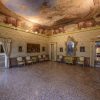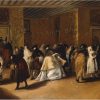This room contains two of the most famous paintings by Francesco Guardi, showing on the left the Parlatory of the Nuns of San Zaccaria and on the right the Foyer of palazzo Dandolo at San Moisè. Thus two “interior views”, which in a certain sense anticipate the town views which Francesco began to paint only in the second half of the century. Notice the quality of the lively figures, which have the same freshness of touch and delicacy of colour as those which were to people his innumerable outside views.
The Foyer shows the large main room of the gaming house of palazzo Dandolo in San Moisè, whose walls were lined with “cuoridoro” before 1768, when the interior of the old palace was restructured in Neoclassical style according to a project by Bernardino Maccaruzzi. The Ridotto, or Foyer, was operated directly by the State and remained open during the months of the endless Venetian carnival, lasting from December 26th to Ash Wednesday. Anyone visiting the premises was required to wear a mask, with the exception of the noblemen who ran the gambling tables, who were chosen from the least prosperous families, the socalled Barnabotti class of impoverished nobility. Frequented by pimps, prostitutes and usurers, it was closed for reasons of public order in 1774. Guardi’s painting is certainly the most interesting depiction of this space, visited by all travellers spending any time in the city.
The Parlatory instead shows the visiting-room of the convent of San Zaccaria, one of the most important in Venice, where descendants of the noble Venetian families were sent to become nuns. Here, relatives and friends could converse with the nuns and during these meetings puppet shows were also put on for any small guests.
A fresco stripped from a reception room of Palazzo Nani in Cannaregio has been fitted to the ceiling. It shows Conjugal harmony crowned by Virtue in the presence of Justice, Prudence, Temperance, Fame, Abundance, and is the work of Costantini Cedini, a late pupil of Giambattista Tiepolo. The decorative frame surrounding the central scene was painted about a century earlier by the trompe l’oeil painter Antonio Felice Ferrari.
The greenish-yellow lacquer suite of furniture with floral decorations is of notable quality; it comes from Palazzo Calbo Crotta at Gli Scalzi. Particularly fine is the large curving chest of drawers with the marble top, surmounted by the imposing but slender mirror with its lovely gilded crest; and the two twin bedside tables with their similar rocaille lines, again repeated in the ten elegant armchairs, whose upholstery is however modern. The frame which fixes the wall covering is also from the same period.


